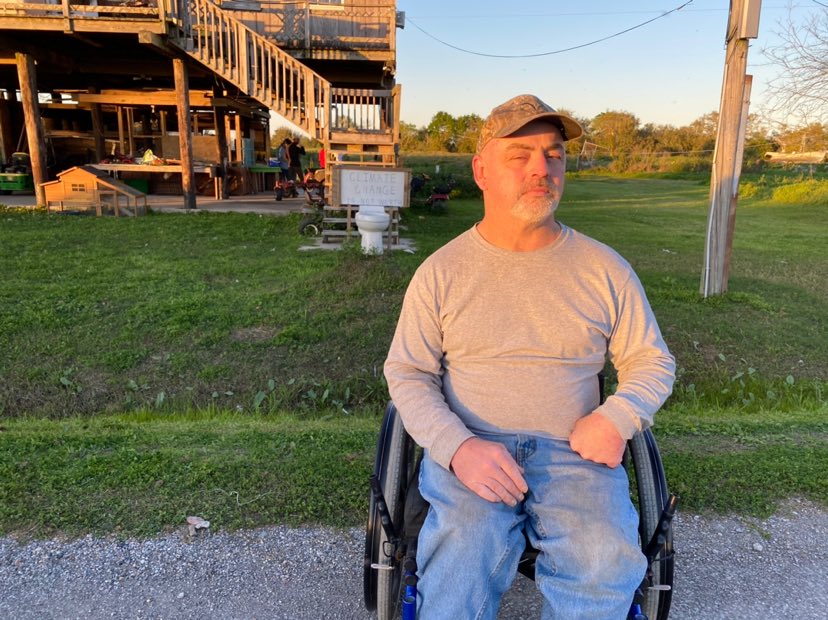Indigenous to the Isle
Outside of a stilted house at the tip of Louisiana’s coastal wetlands, an artistically renovated toilet displayed a sign that read, “climate change is not worth _.”
The exhibit belongs to Biloxi-Chitimacha-Choctaw tribal member Chris Brunet, whose family has been living on the Isle de Jean Charles for at least seven generations.

“The big talk is always climate change,” said Brunet. “Every environment is affected by climate change in some kind of way. There’s more than just one coastal community in Louisiana and all along the coast of the U.S. being affected—and all across the world.”
Brunet attributes his experiences with a changing climate to a complex issue of erosion both naturally caused and manmade. In 2003, Brunet’s grandmother grew tired of hurricanes bringing in floodwater and mud but refused to leave the island, so she had the house raised.
Three years later, drainage levees were installed to protect the community from high tide. Brunet recalled seeing a waterspout tear through to the large drainage ravine across the road during a storm, “This here did fill in like a bowl. And then you have to wait for the tide to go down and you can see the top of the levee. Then the pump can pump out the rest of the water, which takes about three or four days.”

His father was a fisherman who used to walk through muddy marshland to a nearby lake. Now, Brunet says that same lake is only accessible by boat.
Though many coastal residents have relocated to higher ground, Brunet and his family have decided against moving. He said the only way that the isle will lose its sense of community is if they allow it to. “You don’t want it erased,” he said. “You want to keep what you have.”
Environmental migration orders have been issued to protect vulnerable communities from the risk of worsening floods along Louisiana’s Gulf Coast. After Hurricane Katrina, many retreated, though others exhibited great resilience and adapted to a flooded and economically damaged landscape. In a city that lost more than half its population after Katrina, New Orleans’s Lower Ninth Ward continues to feel the ramifications of the storm 15 years later.
After the Floodwall Breached
When the Industrial Canal Flood Wall breached in the storm surge, the Lower Ninth Ward took the brunt of the flood that killed hundreds, destroyed homes and demolished the landscape. Now, much of the area remains vacant and appears more as a dumping ground than as the neighborhood full of families it once was.

“The area was so devastated. We had houses that were wiped out—gone—they just floated away,” said Jimmie Harris, a Lower Ninth Ward firefighter who was on duty during Hurricane Katrina. He described the area after the surge as being layered in three inches of mud and debris that reeked of a “raw, sewer-like smell.”
After a few weeks, Harris was able to return to his own house in the neighborhood to find everything had been swept to his front door with the residing water. His family, who had been sheltering in Huston, remained there for three more years while he rebuilt. Even then, Harris admitted it took a bit of effort to persuade his wife to return.
“The community tried to help each other, but everybody needed help,” Harris said. “It was kind of everybody on their own.”
Many residents, the majority being elderly or retired, never returned, and the ward became a reclusive section of the city.

People are coming back slowly now, but not at the rate Harris had once hoped. On his block alone, there are four empty lots with no prospective buyers.
Fifteen years from now, Harris said hopes to see, “all the houses rebuilt, kids playing, families going to work like it was before.”
Deep Bayou Country
Patricia Reels has lived her whole life in Houma, deep in Louisiana’s bayou country. When a strong storm is predicted, she boards up her house and evacuates the area, as she did in 1992’s Hurricane Andrew, which brought 140 mph winds ripping through Houma.

“I remember seeing the neighbor’s porch spinning around in the air in a hurricane,” said Reels says, who has both flood and wind insurance. “Some people still can’t afford to have their homes raised up.”
Reels says these financial disparities are proportionate to racial inequality and prejudice in the area, as Confederate flags are paraded off porches down the street. “Why should I be racist? How you hate me, and you don’t know me?” said Reels, who says she has indigenous Choctaw, Asian, Black and White roots. “Treat people of color the way you want to be treated yourself.”